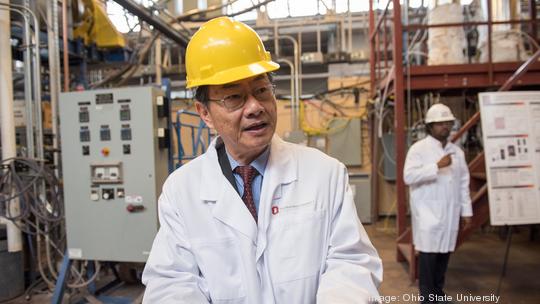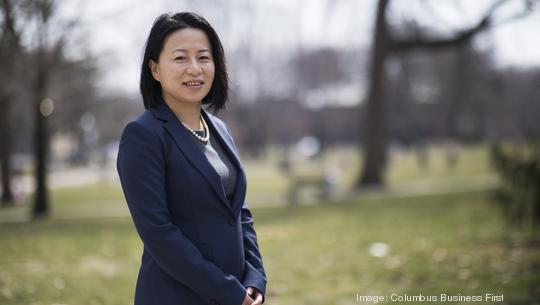
Through much of his four-decade career at Ohio State University, Liang-Shih Fan has worked to perfect a chemical "looping" process that captures nearly all the carbon dioxide released when burning fuel. It's an old concept, but the distinguished professor of chemical and biomolecular engineering discovered a cost-effective way to deploy it at industrial scale.
The technology is now part of a plant under construction in Australia to produce clean-burning hydrogen fuel from lumber milll scraps it's keeping out of landfills. Other potential applications include eliminating CO2 emissions from coal-burning power plants.
It's the latest deal in which OSU is seeing dividends from discoveries that require long-term commitments but could change lives.
OSU licensed the tech in November to an Akron clean energy company co-developing the plant in Australia. Babcock & Wilcox Enterprises Inc., which has worked with Fan in developing the technology, now offers chemical looping in its "net zero" energy portfolio. Customers in several industries are showing "tremendous interest," a company spokesman said.
"This is truly a technology that has the potential to change the world," Babcock & Wilcox said in a statement.
"That is really what is motivating our team every day, the societal impact," said Grace Wang, OSU executive vice president for research, innovation and knowledge enterprise. "The licensing revenue and everything else follows."

Under three previous presidents over the past 15 years, OSU commercialization officials have often pointed out that those income streams don't follow immediately. After years of developing and proving a technology, then comes protecting the IP, building prototypes, negotiating a license or spinoff deal, navigating regulatory hurdles, perfecting processes for large-scale production – the list goes on.
Ohio State had record licensing income in 2018 and 2019, largely from its equity stakes in Nationwide Children's Hospital spinouts that were acquired, one after going public. Revenue declined to $5.7 million in fiscal 2020 and $3.2 million in the year ended June 30 – still well above long-term trends. And the numbers of cumulative revenue-generating licenses and spinoffs is at an all-time high, good signs for the "shots on goal" strategy of tech transfer programs across the country.
Besides the clean energy tech, fiscal 2022 wins so far include:
- Boston-based Entrada Therapeutics Inc., which already had had the largest funding round of any OSU startup when it launched licensing a therapy for muscular dystrophy, raised $181.5 million before expenses in its November stock debut. (Equity holders cannot comment during a mandated quiet period.) It's the largest-ever IPO of a spinout.
- The FDA gave "fast track" designation to an investigational therapy for a rare inherited condition causing noncancerous but debilitating nerve tumors. Utah-based Recursion, which licenses the therapy for neurofibromatosis, plans to enroll patients this year in a combined phase two and phase three trial.
Getting a discovery into the hands of doctors, employers or consumers can take many forms besides a licensing deal, said Kevin Taylor, associate vice president of technology commercialization in Ohio State’s Corporate Engagement Office.
For example, corporations sponsor about 16% of annual research expenditures, which means they might get first crack at resulting technology, or have a non-exclusive deal that means the university can pursue other markets.
The value lies in whatever method reaches the most people, Taylor said in a joint interview with Wang.
"The land-grant mission and commercialization really aren’t at odds," he said. "(Discoveries) may contribute to knowledge, which is valuable and important, or they may not have impact on society without going through the commercial channel."
OSU over the years has set aside funding to develop prototypes, created investment funds managed by Rev1 Ventures, and works closely with Rev1 and private venture partners including Ikove, an international investor group that specializes in commercializing university tech, and Ohio Innovation Fund, which counts OSU as its largest founding limited partner.

Taylor was hired from a California startup in 2018, following previous technology commercialization roles at Battelle and Cardinal Health Inc.
"Those business practices that I’ve learned over my career, that’s what we’re doing here," he said.
OSU President Kristina Johnson, who started in 2020, has increased emphasis on bringing about economic and societal change through innovation, adding Wang to her cabinet.
Commercialization officers are sometimes asked to take part in recruiting interviews for researchers who want to know if OSU would back them in starting a company, he said.
"People are hungry and they’re engaged, and we have an organization now that can help meet them and continue on that journey of entrepreneurship," Taylor said. "I’ve been exposed to many candidates where that matters a lot."
The office also is proactively reaching out to existing faculty even before they have an invention in hand, to familiarize them with the process. Past commercialization chiefs have said much the same, but Taylor said the office had a much smaller staff for many years.
"I really see this as a unique time in Ohio State’s history as it relates to the research enterprise and innovation ecosystem," Taylor said. "This is no commentary on what’s happened in the past."
The more than $1 billion Innovation District under construction on west campus is expected to fuel the fire. The Interdisciplinary Research Facility is on track to open in mid-2023. And an energy innovation center in collaboration with French company Engie will focus on things like smart home technology and more greenhouse gas reducers like the license to Babcock.
"It’s a very, very, very good time to be doing what we’re doing," Taylor said.
Governmental, corporate and private groups including JobsOhio and One Columbus are collaborating more closely than ever to make OSU "the intellectual engine to grow the economy," Wang said.
"We see the excitement among our faculty members, among our community, among our investors, moving along with this entrepreneurial mindset," she said. "We are so excited to be at the right time with the right support.
"Columbus is getting ready to take off."



